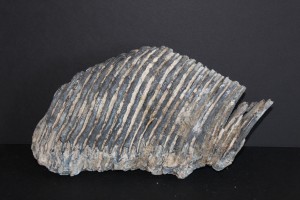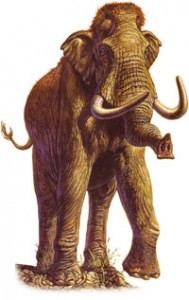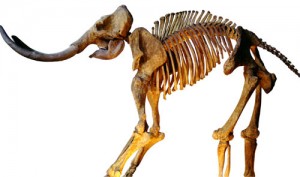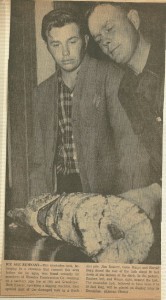by Kristine Schmucker, HCHM Curator
A recent list on Smithsonian.com, made me wonder, (click here), what is the oldest artifact at HCHM? In our collection, it is a mammoth molar discovered in Harvey County almost 50 years ago.
Columbian Mammoth Molar
During the construction of I-35 in 1966, a Columbian mammoth molar was discovered one-fourth mile north of the Harvey/Sedgwick County line. It was donated to the museum by Kenneth Meier.
- Columbian Mammoth Molar, HCHM #2001.27
In the Late Pleistocene Period, over 11,000 years ago, the Columbian mammoth (M.columbi), also known as the Jefferson mammoth, appeared in North America. These large beasts roamed present day United States and Central America. At about the same time, another mammoth, known as the woolly mammoth (M. primigenius) appeared in Eurasia. The woolly mammoth eventually migrated to North America, as far south as Kansas, where their range overlapped with the Columbian mammoth.
Scientists believe that the habits of these great creatures were similar to modern day elephants. Based on the eating and drinking habits of modern elephants, scientists have determined that mammoths spent between 16 and 18 hours a day either feeding or moving toward a source of food and water. They consumed between 130 to 660 pounds of food a day and drank up to 40 gallons of water. All of which resulted in between 310 to 400 pounds of dung a day. Columbian mammoths were grazers, eating mostly grasses, sedges and rushes. For that reason their teeth had ridged molars that ‘acted like mill-stones, with varying hardness across the grinding surfaces.”
The Pleistocene Epoch lasted from about 1.65 million until 10,000 years ago. During that time, North America looked and felt very different from today. While the glaciers were retreating, much of the central part of the US was still covered in ice. Even though winter was only slightly colder than today, summers were significantly cooler. Scientists, also believe that there was much more diversity among large mammals during this time. The central U.S. may have resembled modern Africa with many different species.
The Columbian Mammoth died out about 11,000 years ago.
Other Traces of Pre-historic Harvey County: Mastodon Tusk
During construction work on a sanitary pipe line at 12th and Grandview, Newton, a mastodon tusk was unearthed.
According to the clipping, members of Rhoades Construction Co. discovered the tusk. Herb Keazer noticed a portion of the tusk in a pile of fresh dug dirt. The rest of the tusk was discovered twenty feet down at the bottom of the ditch by Jim Rosiere, Gene Wingo, and Harold Berg. A future blog post will tell the story of this pre-historic discovery.
Sources:
- Newton Kansan, undated clipping in HCHM Photo collection #2012.166.10.
- http://www.ucmp.berkeley.edu/mammal/mammoth/about_mammoths.html Images of Skeletal mount and Columbian Mammoth are from this site.
- http://exhibits.museum.state.il.us/exhibits/larson/LP_extinction.html
- http://www.smithsonianmag.com/travel/whats-oldest-thing-you-can-see-museum-180953279/?utm_source=smithsoniantravandcult&utm_medium=email&utm_campaign=201411-travel&spMailingID=21723592&spUserID=NzQwNDU3NjE1MzYS1&spJobID=442150067&spReportId=NDQyMTUwMDY3S0





